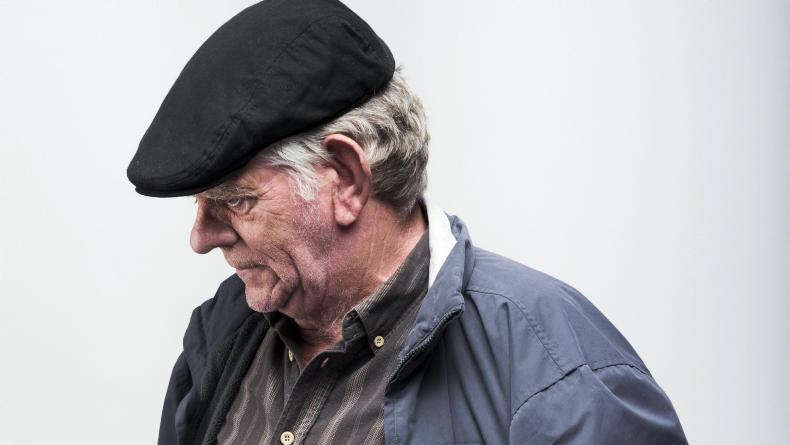Sitting on a stool in the local pub Tigh Thaidhg with a hot cup of coffee and an empty pint glass in front of me, I glance down at the floor. After a couple of seconds it dawns on me that the ‘tiles’ underneath are not such, but actually a surface painted on with painstaking precision.
Further investigation around the set of Ros na Rún proves that all the different rooms in the series have painted on floors, whether it be tiles or wood. I’m curious as to why. A trip to Sweeney Oil answers my question. Around the side of the service station there is an orange door with a battered sign saying ‘leithreas’.
Like much of Ros na Rún’s set, all is not as it seems. Inside the door is not a toilet, but in fact the art department. Art directors Sarah Lally and Maddy O’Donnell explain that the floors are painted on to create a smooth surface for the cameras. If tiles or wood were put down the grooves would cause bumps during filming.
The art department is where all the fine details are adhered to. When we drop in Maddy is designing fake labels for shampoo bottles and Sarah is creating graphics for Fiosrach, Ros na Rún’s version of Facebook that is sometimes seen on characters’ mobile phones.

Lights, camera, action
With the minute margins I’ve been exposed to thus far, I’m not surprised when I’m informed that in fact I’m going to be on screen myself as an extra. As I attempt to remember everything I learned in speech and drama, the bombshell is then dropped that I will have a line. An actual line, as Gaeilge - albeit it is only “go raibh maith agat”.
The scene is being filmed in Tigh Thaidhg. Emma is sitting opposite me and gives a crash course in acting. I’m told 1) not to look into the camera and 2) mouth words, don’t make noise. Silently saying A,B,C,D,E while making some slight facial expressions is a good trick, I’m told. Macdara Ó Fátharta, playing Tadhg, is collecting the glasses from our table. I thank him before he goes off and becomes embroiled in a kerfuffle.
I get my four words out without a hitch and plenty of practice saying them too, as we have to shoot the scene a number of times due to a game of shadow spotting, as the seasoned professionals call it. Shadows from the boom mics sometimes slip into scenes, the offending equipment has to be located and reprimanded before we can continue.
Across two weeks on the set of Ros na Rún seven episodes are shot. There is an A and B set, both in use at the same time, and actors can be working on multiple episodes at the same time.

In focus
In getting to most television studios you drive towards an urban hub. In the case of Ros na Rún, shot in the Connemara Gaeltacht village of Spiddal, you are driving away from the city. For the 24 weeks each year it is filmed, Ros na Rún’s production company, EO Teilifís employs 150 people and also a cohort all year round.
During this summer’s break a €1m investment in set refurbishment and new equipment facilitated Ros na Rún becoming Ireland’s first soap to be aired in high definition (HD). Along with a sharper picture, the effects of moving to HD were mirrored right across the cast and crew.
In the makeup department Máire Ní Dhroighneáin explains that because of the better quality, her team had to pair back the war paint slightly. Coming out from getting his make done before going on set is none other than Ros na Rún’s resident farmer Cóilí Jackie, played by Máirtín Dubhghaill.
Cóilí Jackie has only been on TV screens a year and a half, but the mistrusting bachelor farmer has proven a big hit with audiences. “He’s living on his own and he had a tough childhood,” remarks Máirtín of his character. “He planned to go to England, but he had to stay home and mind the father who was sick.”
At present Cóilí Jackie is in a storyline with Frances. Máirtín isn’t giving too much away, only saying that Tadhg’s blessing may not be as it seems. Watching on screen, most would think Máirtín was an actor all his life, but in fact he is a retired school teacher.
“I wasn’t always into acting at all. I’m living here in Connemara and the local acting group Cumman Dramíochta Cois Fharriage once or twice were stuck for someone to fill in and then I got a few parts with them over a number of years, but it was nothing very serious,” reflects the actor.
“I was teaching for 40 years. I’m originally from Limerick, the city. I gave three years teaching in Thurles and 11 years teaching in Southhill in Limerick, then I moved up here in 1981. I was teaching in St Pat’s in Galway.”

Tips and tricks
As with most TV studios, there are tonnes of tips and tricks in making sure everything looks realistic, but is also functional for filming. On the set of Ros na Rún there are a number of urban (or should we say rural) legends that the cast and crew have passed down.
Apparently, someone once wandered on set and tried to use the ATM on the street. It is also bandied around that a tourist found their way to Príomhshráid Ros na Rún and stood waiting at the bus stop down from Tigh Thaidhg. Rumoured too is that staff were taking so much chocolate from the siopa that they had to start injecting the confectionery with TCP. Is it true, who knows?
Working on a soap may feel like living in a fantasy world, but there’s plenty of engineering and hard word that goes into creating it.
